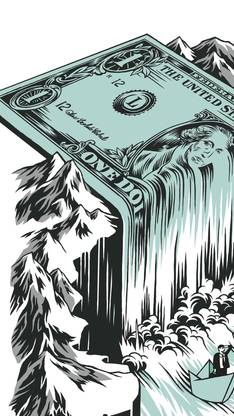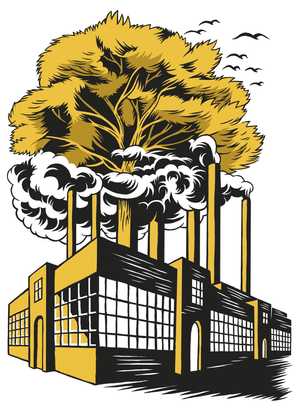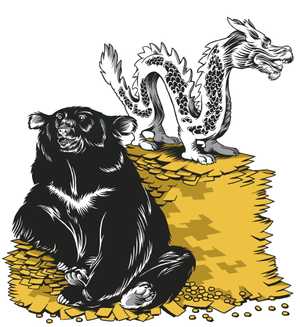Five key trends for 2009 / Global
The smart money
The world recession, climate change and volatile oil prices will take their toll on businesses, but they also herald new opportunities. Monocle looks at the migration of wealth and the changing face of the business landscape. And why 2009 is the best year to start a company.


01 Opportunity knocks
Meet the new banker-preneurs
While the world economy shivers in the midst of a nuclear winter, what is the next generation of economics graduates, shut out of a fast-track cash-in with Lehman Brothers or Daiwa SMBC, to do? The answer is as counterintuitive as a bout of short-selling: to morph from venture capitalists into “banker-preneurs”.
Recession is the best time to start a business‚ says Mike Southon, Financial Times columnist and entrepreneur mentor, whose own start-ups were launched in the previous economic down-turns of 1984 and 1991. “In hard times, people, raw materials and office space are cheaper, and suppliers turn up on time and offer reasonable returns. There’s only one way to beat a recession, and that’s to sell your way out of it. But you have to sell security rather than excitement. I’m already seeing a lot of people who would have gone into banking take the skills they’ve honed –analytical ability, planning and budgeting, delivering ideas in a compelling way, training talent – and use them to found their own companies, many of which are lifestyle or social enterprise-related.”
The evidence from Japan, and its recession of the mid-1990s, seems to bear Southon out. Although the country has the world’s second largest GDP, the conservative nature of its society had until then meant entrepreneurial activity and its attendant risk-taking had remained low. However, following the recession, the total number of the country’s small and medium-sized enterprises (defined as those employing between four and 299 employees) has risen to nearly five million, employing nearly 30 million people, or 70 per cent of the country’s total workforce.
One advantage that banker-preneurs have in wobbly economic times is flexibility. “Big businesses are notoriously immobile and pedestrian, failing to react to volatile markets. Meanwhile, the internet has democratised business, and barriers to entry are lower than ever before. So today’s start-ups are better placed to take advantage of any opportunities than in any previous down-turn,” says Southon.
Of course it will not all be plain sailing for banker-preneurs: funding, especially for growth, will be more difficult to acquire. But, as Southon points out, who would be better equipped at capital-raising than a thwarted hedge-funder or investment analyst? Not only that, but start-ups hatched in unpropitious times tend to be the ones with staying power.
And for the especially canny and creative banker-preneur, the rewards could be greater than any provisory bonus. Microsoft, Johnson & Johnson, Compaq, and Hewlett-Packard were all launched during previous recessions. “They were leaps of faith that bore spectacular fruit,” says Southon. “Who is to say we won’t see a similar crop coming through this time round?”
02 Air turbulence
The winners and losers of aviation
The combination of a financial crisis, global recession, shrinking demand and volatile fuel prices have hit aviation with a force that many consider worse than both September 11 and SARS. Current business models will be put to the ultimate test in 2009. There are still far too many carriers being seen through by state owners reluctant to abandon the idea of flag carriers. Some will finally go under or be taken over in 2009, most notably Alitalia.
In Europe it could become the year of Lufthansa. It has taken over BMI, and Austrian, Scandinavian Airlines and Alitalia are all on the Germans’ shopping list. “Lufthansa will take over at least two other carriers,” predicts analyst Jürgen Pieper at Metzler Equities in Frankfurt.
The crisis should result in a strengthening of the three major airline groups in Europe, with smaller carriers seeking refuge beneath their wings – as well as Lufthansa, these are Air France-KLM and British Airways. Meanwhile, the number of bankruptcies worldwide will increase from the 34-plus that failed during 2008, including, most recently, Danish low-cost carrier Sterling.
Bad times could be good times for some low-cost carriers though, especially with hard-hit business travellers trading down. “Ryanair and easyJet will be the winners,” says Pieper, but “weaker low-cost airlines will face problems.”
And don’t write off low-cost long-haul; Malaysia-based AirAsia X proves the model can work. It starts flying to London-Stansted from Kuala Lumpur in March and has 25 Airbus A330s on order. Ryanair’s Michael O’Leary is also mulling starting a cheap long-haul operation as soon as big carriers go bust and he gets his hands on cheap aircraft.
Andreas Spaeth is a leading aviation correspondent
Going up:
Lufthansa The Germans are said to be buying everything that moves.
Air France-KLM The successfully merged airline will grow in importance.
AirAsia X The coming success story of long-haul low cost.
Going down:
Alitalia The Italian tragedy carries on and waits for a saviour to be found.
SAS Too small to go it alone, too big to just become a junior partner somewhere.
Austrian Desperately trying to survive under the wings of Lufthansa.

03 Fuelling change
Rethinking energy issues
The new year is set to be the most important moment in our energy history since the flurry of interest, innovation and – for a short time – funding we saw in response to the OPEC oil embargo three decades ago.But back then, as the energy crisis faded and oil prices fell from then-record highs of $90 a barrel to record lows of under $20 a barrel, so too did interest in energy issues. At first blush, we face similar forces today that could again undermine progress: a weak economy and oil prices that, while volatile, have fallen from highs of $140 a barrel, to less than half that by late 2008. Yet beyond that, the similarities fade largely due to climate change and increased global demand for energy. The landscape of opportunities to change the energy picture is very different.
We have the promise of a new and innovative US in the form of the Obama administration that is committed to a dramatically new path for the country that, until recently, was the largest emitter of greenhouse gases (it’s now China), and is still the leader in energy use per person.
Obama has promised a dramatic shift in energy policy – from a huge increase in funding for basic research and deployment (a 10-year, $150bn programme), to a national 25 per cent target for new renewables by 2025, and a 2050 target of 80 per cent emission reductions (California, Austria, Germany and Sweden have already made this their target). These are components of a fresh US energy consciousness, and portends well for cooperation in the global greenhouse gas negotiations that hopefully will lead to a landmark agreement at cop15, the 2009 Copenhagen climate summit.
At last there is a global explosion of financial and political interest in energy, focused largely on clean energy such as solar, wind and other low-carbon sources. Although investments in CO2-intensive sources are also on the rise, it is new energy technologies that will be the life-blood of economic growth and renewal.
In the US and China there are other opportunities too. Each is dependent on coal, but jointly they have the technical capacity to change that. Both have exceptional wind and solar energy resources.
Meanwhile the EU and regional partnerships in the US have put a market price on greenhouse gas emissions permits and Obama has called for such a system for the US as a whole. The development and expansion of this system is vital as it may help to reorient innovation and economic forces toward the low-carbon economy our planet needs.
Daniel M Kammen is an academic specialising in energy policy

04 What’s in store
Retail shake-up
I believe the economic crisis will work in the favour of our shopping streets – the rental structure is already being re-examined, and opportunities are arising for small brands and entrepreneurs. That “sameness” we have seen for years will go – turbulent times inspire innovation and re-imagination. We’ll see the spread of the temporary, streetside format as brands are forced to corner their customers in new ways. Why hasn’t American Apparel set up temporary cabins – as you see retailers do in Paris and Moscow – at summer festivals? Why do newsagent chains not have stands in the centre of big major pedestrian routes in London? Brands should look at the innovation of Comme des Garçons, which championed the guerrilla store, the reworking of the fashion emporium with Dover Street Market, and is now planning hundreds of small footprint pocket shops. Companies will also have to overhaul customer service and improve their merchandise in order to bring back the consumer.
The most important revolutionary in the market is the internet, whose challenge to the traditional means of trading is still immeasurable. But the web could be the best cure for the afflictions of our high streets, and a great support for specialist stores in the months ahead. People will always want that Saturday trip to the shops, not just a keyboard experience, but in the near future I see our options for buying things such as books, CDs and DVDs being limited to the likes of play.com and Amazon. Many of the bigger music shop chains, for example, will vanish. However, the market for family-run places that stock that rare vinyl or limited-edition novel will grow.
I am writing this from Russia, one of the most interesting retail markets in the world. It is frightening to see the growth here – entrepreneurs who own portfolios of 50 stores built up in just five years. Yet even here, in the past few weeks, it is as if the tap has been turned off. Japan will remain the most sophisticated retail marketplace. Space in Tokyo is at a premium, so firms such Beams and Muji have to make spaces work hard – again they offer a masterclass for many tottering firms. Witness Muji’s new tie-up with venerable Austrian chair firm, Thonet.
People will of course continue to shop in 2009, but they are going to be more discerning. Brands that have a great formula of good, lasting quality will see it through but they will have to adapt. The customer is in control again.
David Wilkinson runs retail consultancy Wilko

05 The economic life jacket
Emerging markets and governance
What’s the difference between an investment banker and a large pizza? The pizza can still feed a family of four. As markets crash to new lows every few days and headlines blare out more news of financial panic, it’s hard to be optimistic about anything other than the rich vein of trench humour in all the chaos.
Behind the jokes, though, the fact remains that the world is undergoing a huge transfer of wealth, from West to East and from more developed markets to the less well off. Growth in emerging markets is likely to be infinitely stronger than in many parts of the developed world, with estimates for China hovering over 8 per cent and Russia at around 5 per cent, compared with sub-zero growth in Europe, say economists. Last year’s myth was that emerging markets, from China and Russia to Brazil and India, would grow so fast that they would be able to charge ahead, pulling the global economy with them, and leaving the wounded US consumer in the dust. Anyone who has ever lived in China or Russia and seen the way ordinary people stash their money in the bank for a rainy day – in contrast to the plastic-flashing, SUV-driving culture of the US – was unsurprised to see that idea go up in smoke. But those savings could now be a great source of strength.
If the optimists who thought China could rescue the rest of the world have got carried away, the pessimists may have now gone too far. Emerging stock markets have crashed dramatically over the past few months, and some of their biggest companies are now extremely cheap.
Jonathan Garner, emerging markets strategist at Morgan Stanley, says that income per head in China is level with that of Japan in the mid-1960s and it will continue to grow, driven by the average citizen feeling gradually wealthier. “China will be the single biggest contributor to global growth in 2009,” he says, adding that, “People underestimate China’s ability to fund consumption and investment. They have a very high household savings rate.” While in the West consumer spending fuels growth, in China investment is the biggest engine of growth. This means the government can oil the country’s economic cogs much faster than European and US leaders, says Arthur Kroeber of Beijing consultancy Dragonomics.
While economies from Brazil to Belgium face a rocky road over the next year, and stock markets may have some way to go before they hit the bottom, the broad trend of faster growth in emerging economies is here to stay.
“The advantage that Russia and China have is that they are sitting on mounds of probably the world’s most precious commodity: cash. Eventually, when the dust settles, this will make them the prettiest girls in the room,” says Akber Khan, an equities strategist at Deutsche Bank. But he warns that the settling of the dust will be a messy process.
Rachel Morarjee is markets correspondent at the Financial Times
Going up:
China High savings rates mean consumers can still spend, while the government can also inject cash into the country’s economy.
Russia It’s going to be a tough year for the billionaires, but growth should keep going at a steady 5 per cent clip.
Brazil It will be hit by the slowing demand for commodities, but the economy is large enough to weather the slowdown.
Going down:
Ukraine A hostile Russia on its borders, a tottering property boom and a high rate of domestic borrowing. Its currency looks shaky.
Pakistan Turbulent politics, rising Islamist militancy – the country has already gone cap-in-hand to Japan.
The Baltics Already in recession and could face a tough 2009 if Sweden’s banks struggle to fund lending in the former Soviet republics.


